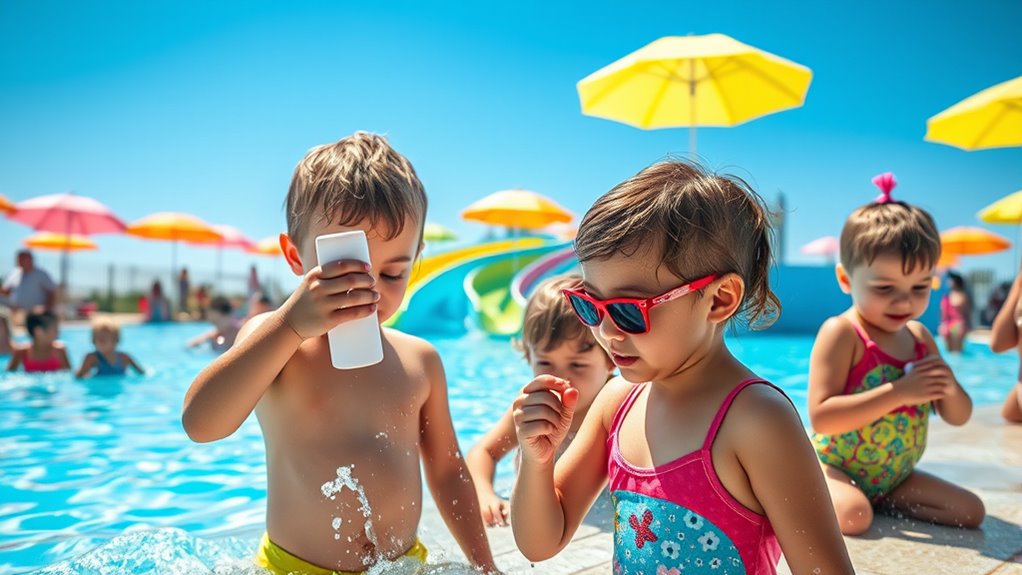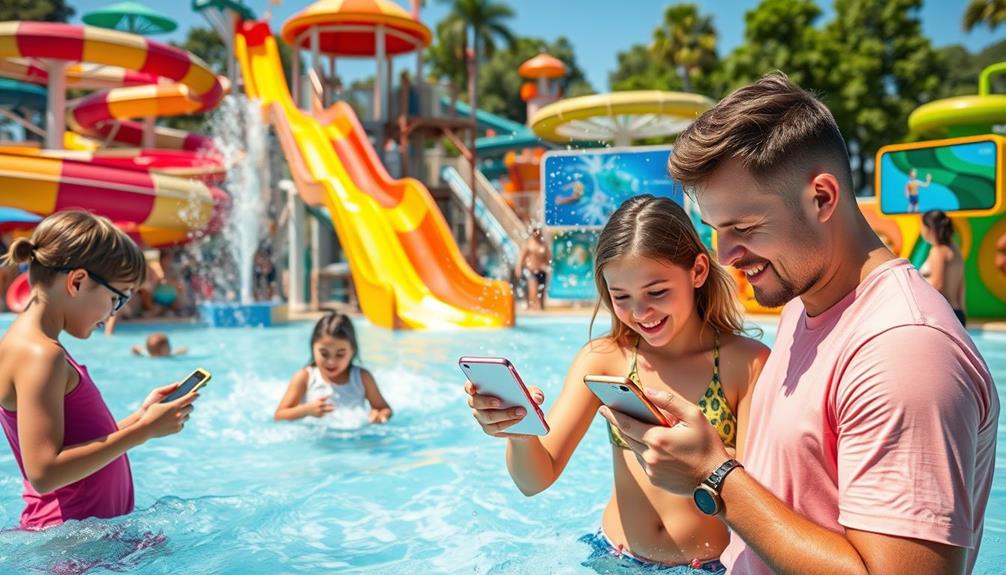When protecting your skin at water parks, choose a broad-spectrum, water-resistant sunscreen that blocks UVA and UVB rays. Reapply every two hours, or sooner after swimming, sweating, or towel-drying, to keep coverage strong. Remember to cover all exposed areas and use enough sunscreen each time. Proper reapplication and the right product guarantee you stay safe while enjoying water activities. Keep going for more tips on how to maximize your sun protection.
Key Takeaways
- Choose a broad-spectrum sunscreen to protect against both UVA and UVB rays at water parks.
- Use water-resistant sunscreen, which lasts longer during water activities but still needs reapplication.
- Reapply sunscreen every two hours, or more often after swimming, sweating, or towel-drying.
- Apply about one ounce of sunscreen evenly over all exposed skin for effective coverage.
- Cover often overlooked areas like ears, back of neck, and tops of feet during reapplication.

Visiting water parks is a fun way to beat the heat, but sun protection should never be overlooked. When you’re splashing around and enjoying rides, your skin is exposed to the sun’s rays for extended periods. Without proper protection, you’re at risk of sunburn, skin damage, and even long-term health issues like skin cancer. That’s why choosing the right sunscreen is essential. Look for a broad-spectrum formula, which shields you from both UVA and UVB rays. UVA rays penetrate deep into the skin and contribute to premature aging, while UVB rays cause sunburn. Broad-spectrum sunscreens offer all-encompassing protection, so your skin stays safer during your water park adventure.
Water-resistant sunscreen is your best friend in these settings. Unlike regular sunscreen that can wash off quickly when you’re swimming or sweating, water-resistant formulas stay on longer, providing steady protection through water and activity. Keep in mind, “water-resistant” doesn’t mean waterproof; it simply lasts longer when wet. Usually, water-resistant sunscreens are effective for about 40 to 80 minutes of swimming or sweating. To maintain continuous protection, you need to reapply sunscreen regularly. The general rule is to reapply every two hours, but if you’re swimming frequently, sweating a lot, or towel-drying yourself, you should reapply sooner. After swimming or towel-drying, make sure to apply a fresh layer of sunscreen to keep your skin protected.
Water-resistant sunscreen lasts longer during swimming and sweating; reapply every two hours for continuous protection.
Timing your reapplications is critical. Even if you’re using a water-resistant product, the effects diminish over time. Set a timer or make a habit of reapplying at regular intervals, especially after water activities or excessive sweating. If you’re planning to spend a significant amount of time outdoors, bring enough sunscreen so you can reapply as needed. Don’t forget to cover often overlooked areas like your ears, back of your neck, and the tops of your feet. These spots are particularly vulnerable to sun damage because they tend to be exposed and are often missed during reapplication. Additionally, understanding how water chemistry can affect sunscreen effectiveness can help you choose products that last longer during your water park adventure.
Applying sunscreen properly is just as important as choosing the right one. Use about a shot glass full (roughly 1 ounce) for your entire body, and make sure to spread it evenly. Be generous and thorough, covering all exposed skin. Don’t forget areas like your scalp if you have thinning hair or bald spots, and reapply whenever you notice the sunscreen has worn thin or been washed away. With diligent reapplication and the right sunscreen, you’ll enjoy your water park day while keeping your skin protected from harmful UV rays.
Frequently Asked Questions
Can I Use Spray Sunscreen on Children at Water Parks?
Yes, you can use spray sunscreen on children at water parks. Just make sure it’s labeled as broad-spectrum and water-resistant. Spray it evenly over their skin, holding the can several inches away, and rub it in for full coverage. Remember to apply it generously and reapply every two hours, especially after swimming or sweating. Always supervise children during application to avoid inhalation or contact with eyes.
How Long Does Water-Resistant Sunscreen Really Last?
Water-resistant sunscreen typically lasts about 40 to 80 minutes when you’re swimming or sweating, but it can vary based on activity and product. You should reapply it immediately after swimming, towel drying, or sweating heavily. Remember, no sunscreen is completely waterproof, so frequent reapplications ensure your skin stays protected. Always check the label for specific reapplication instructions and reapply generously for continuous protection at water parks.
Are Mineral Sunscreens Better Than Chemical Ones for Water Parks?
You’ll find mineral sunscreens often better for water parks since about 90% of people have sensitive skin and mineral options are less likely to cause irritation. They sit on your skin and reflect UV rays, offering immediate protection without needing as frequent reapplications. Plus, mineral sunscreens tend to be more environmentally friendly, making them a smart choice for water parks where water safety is a priority.
What Ingredients Should I Avoid in Water Park Sunscreens?
You should avoid sunscreens with oxybenzone, octinoxate, and homosalate, as these ingredients can harm coral reefs and marine life. Also, steer clear of sunscreens with artificial fragrances and parabens, which can cause skin irritation. Instead, look for mineral sunscreens with zinc oxide or titanium dioxide, as they’re safer for the environment and gentle on your skin. Always check labels before applying it at water parks.
How Can I Prevent Sunscreen From Coming off During Water Rides?
Did you know that 80% of skin damage occurs before age 18? To prevent sunscreen from coming off during water rides, apply a broad-spectrum, water-resistant sunscreen generously 15 minutes before getting wet. Reapply immediately after any water activity, and use a sweat-proof, sport formula for better staying power. Wearing UPF clothing and seeking shade also help protect your skin throughout your water park day.
Conclusion
So, next time you head to a water park, will you prioritize broad-spectrum, water-resistant sunscreen and reapply regularly? Protecting your skin isn’t just about staying comfortable—it’s about preventing long-term damage. Water slides and pool days are fun, but they can quickly deplete your sun protection. Are you ready to make sunscreen your ultimate water park essential? Remember, with the right protection, you can enjoy every splash without worry.









